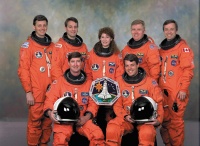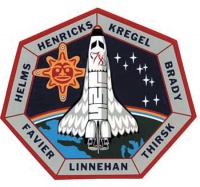STS-78
From The Space Library
 | |
| Organization | NASA-Office of Space Flight (United States) |
|---|---|
| Mission type | Human Crew |
| Launch date | June 20, 1996 |
| Launch vehicle | Space Shuttle |
| Launch site | Cape Canaveral, United States |
| COSPAR ID | 1996-036A |
| Experiments | Here |
| Alternate Names | 23931 |
| Additional Information | Here |
| Data Collection | Here |
| Payload Mass Up | 10676.20 kg |
STS 78 was a NASA shuttle spacecraft launched from Cape Canaveral for a 17 day mission. It carried a Spacelab (LMS-1) with many supplies and instruments for 41 microgravity experiments involving fish embryos, rats, Bonzai plants, fluid dynamics, metallurgy, protein crystal growth, etc. Five space agencies (NASA/USA; European Space Agency/Europe; French Space Agency/France; Canadian Space Agency/Canada; and Italian Space Agency/Italy) and research scientists from 10 countries worked together on the primary payload of STS-78, the Life and Microgravity Spacelab (LMS). More than 40 experiments flown were grouped into two areas: life sciences, which included human physiology and space biology, and microgravity science, which included basic fluid physics investigations, advanced semiconductor and metal alloy materials processing, and medical research in protein crystal growth. LMS investigations were conducted via the most extensive telescience to date. Investigators were located at four remote European and four remote U.S. locations, similar to what will happen with the International Space Station. The mission also made extensive use of video imaging to help crew members perform inflight maintenance procedures on the experiment hardware. Previous life science investigations have delved into what physiological changes take place in microgravity environment; the integrated LMS experiments explored why these changes occur. The most extensive studies ever were conducted on bone and muscle loss in space. STS-78 marked the first time researchers collected muscle tissue biopsy samples both before and after flight. Crew members also were scheduled to undergo Magnetic Resonance Imaging (MRI) scans almost immediately after landing. Findings from comparison of the biopsy samples, along with various musculoskeletal tests conducted during mission, could lead to effective countermeasures to reduce inflight muscle atrophy. Other life science investigations included: First ever comprehensive study of sleep cycles, 24-hour circadian rhythms and task performance in microgravity. Spacecraft orbiting Earth pass through 16 sunrises and sunsets in single 24-hour period, which could disrupt normal body rhythms. During two 72-hour time blocks, crew members completed questionnaires and measured such functions as eye movement and muscle activity during sleep. In the Performance Assessment Work Station, crew members performed a series of drills involving math problems and other mental tests to measure the microgravity effects on cognitive, or thinking, skills. The microgravity science investigations included Advanced Gradient Heating Facility, in which samples of pure aluminum containing zirconia particles were solidified. This could lead to more inexpensive ways to make mixtures of metals and ceramics, particularly useful to the metal casting industry. The Advanced Protein Crystallization Facility is the first ever designed to use three methods for growing protein crystals. In Electrohydrodynamics of Liquid Bridges, which focused on changes that occur in a fluid bridge suspended between two electrodes. This research could finds applications in industrial processes where control of a liquid column or spray is used, including in ink-jet printing. The crew performed in-flight fixes to problem hardware on the Bubble, Drop and Particle Unit (BDPU), designed to study fluid physics. The orbiter itself played a key part in a test that could help raise the Hubble Space Telescope to a higher orbit in 1997 during the second servicing mission. Columbia's vernier Reaction Control System jets were gently pulsed to boost the orbiter's altitude without jarring payloads. The same exercise could be conducted with orbiter Discovery during Mission STS-82 to raise HST's orbit without impacting its solar arrays. No significant in-flight problems were experienced with orbiter.

